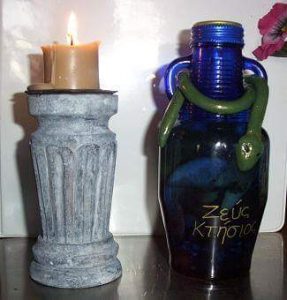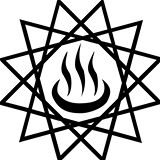by Cara S. and other contributors
The Noumenia is the likely first day of the visible New Moon and is held in honor of the household Gods. The Noumenia is also considered the second day in a three day household celebration held each lunar month – Hekate’s Deipnon is on the last day before the first slice of visible moon and is the last day in a lunar month, then the Noumenia which marks the first day in a lunar month, followed by the Agathos Daimon (Good Spirit) on the second day of the Lunar month.
The Noumenia is a celebration of the start of a new Hellenic month (see the Hellenion calendar for the timing) and seeks blessings for the household. Offerings such as incense or honey cakes are made to your household Gods at your family altar. (A recipe for Honey cake.)
Traditionally, the household Gods consist of Hestia, Zeus Ktesios, and Zeus Erkeios, as well as the gods who protect the household from external calamities: Hermes, Hekate, Apollon Agyieus (Apollo of the streets and highways). You may include your household’s Agathos Diamon and any ancestors you honor. However, many Hellenic Polytheists do honor additional Gods at their family altar. (For more information on the basics of household worship please see this article on the Labrys site or the book Hellenic Polytheism: Household Worship, pp24-29).

& potted olive tree where contents of jar are disposed of each Deipnon.
Some Hellenion members celebrate the Noumenia with the following rituals:
- Decorate their home with fresh flowers, evergreen branches, or other seasonal decorations.
- Serve a big family meal and eat it at the dining room table.
- Create a list of family goals or projects to get done or start within the next lunar month.
- Bake a special dessert that you only make on this day – such as Honey Cake.
- Replace the ingredients in the Kadiskos (see below) with fresh oil, grain, honey, fruit, and bits of food.
The Kadiskos is a small jar containing food stuffs that we receive from the Gods and give back in reciprocity. Refreshing the Kadiskos is part of preparing for Noumenia. Here are directions for Making a Kadiskos in honour of Zeus Ktesios.

Additional information:
Hellenic worship makes notice of the New Moon, because it marks the beginning of the month, rather than the more obvious full moon, although many Hellenic festivals are held during or near the time of the full moon. Adkins and Adkins say: “The first day of the month was new moon day (noumēnia), recognized as a holy day throughout the Greek world. It was so holy that at Athens, no other festival ever took place that day. It was celebrated by a public ritual on the Acropolis and by private offerings of frankincense to statues of the gods” (Handbook to Life in Ancient Greece, p. 351). Herodotus says that, in Sparta, meat, barley meal and wine were distributed to the citizens by the Kings on the Noumenia (Herodotus 6.57).
What might modern worshipers do to commemorate this important day? Like the ancient Athenians, you can burn frankincense and read the Orphic and Homeric hymns to Selēnē. The thin crescent moon, the mēniskos, is often depicted in religious art and suggests the horns of consecration. In the Orphic Hymn to Selene, She is said to be “bull horned” (taurokeros).
Orphic Hymn 9 to Selene says that she “Delights in stillness and in the kindly, auspicious night.” Also, many of the Orphic hymns, and this one especially, reminds us that the arrival and passage of each new month is a reflection of the cycle of lives, with birth following the period of dark death. So as She is “a sure token and a sign to mortal men” (Homeric Hymn to Selene), so we can trust in the cycle of rebirth and renewal.
Noumenia Prayer by Melissa
More hymns / prayers to Selene can be found here.
